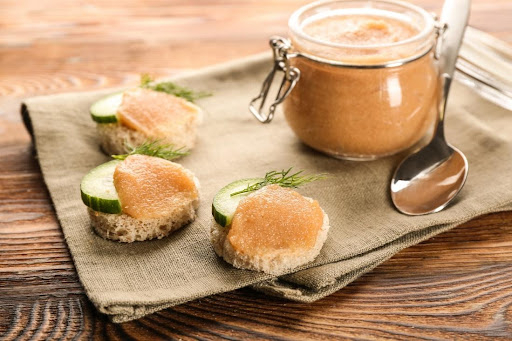
In 1995, a new restaurant caused a stir in London's culinary scene. Set in a former smokehouse near Smithfield market, Fergus Henderson's restaurant 'St. John' brought us the gospel of 'nose to tail eating. Ensuring nothing goes to waste, Henderson would serve dishes that use every part of the animal, from pig cheeks to ox tongue.
Henderson's mantra spurred not only a resurgent love for lesser-used meats cuts, but more recently, an equivalent philosophy for vegetables termed 'root to fruit'. In this line of thinking, cauliflower leaves, broccoli stems, and carrot tops would not be left for the compost but elevated to rarefied heights.
Now, it's the turn of fish to be given this treatment, as a new breed of chefs begin to adopt a more adventurous approach to preparing fish.
Known as 'scale to tail' eating, this concept was pioneered by Australian chef Josh Niland, who showcases the lesser-used parts of fish in highly refined dishes, and uses an innovative dry-ageing process to prevent waste.
On the menu at Niland's restaurant, 'Saint Peter' in Sydney are highly inventive dishes such as a hot-smoked fish turducken, which Niland makes with a tuna loin inside cod, inside a butterflied sea trout. There's also a black fish pudding, guanciale made from fish cheeks and jowls, and wild kingfish pastrami.
'I hope in 20 years this will not be radical thinking but commonplace, to use every part of the fish: roe, liver, stomach, swim bladder, milt, heart, bones,' explains Niland. 'Just like today it would be outrageous to discard beef cheeks or oxtail.'
Following the success of 'Saint Peter', Niland opened another restaurant in Sydney called 'Charcoal Fish'. Hoping to showcase the diverse applications of cod, the menu includes whole rotisserie cod with chips, grilled collards with fermented tamarind hot sauce, gravy made from cod heads, and even caramel ice cream using rendered cod fat.
Describing his whole rotisserie cod dish, Niland explains,'It's as close to roast pork as you'll get. When I run the blade over the fish, you can hear how crisp and crackling it is. We age the fish for six days before putting it on the rotisserie, so as well as the snap and crunch from the skin, you get dripping fat from the flesh, which is more savoury from ageing.'
Niland's dishes are not only delicious but present a more sustainable way to enjoy fish. Indeed, fillets only make up just 50 per cent of the whole weight of cod and haddock, with the rest of the fish – its head, organs, and bones – may often be discarded or ground into fishmeal.
By using parts of the fish that are often overlooked, waste can be dramatically reduced, with the yield of each fish increased from a standard 40-50 per cent up to 90 in 'scale to tail' eateries.
But it's not only Josh Niland that is advocating sustainable cooking practices. Across the world, home cooks and professional chefs are turning to more adventurous ways to prepare fish.
Indeed, in Japan, steamed monkfish livers are a speciality, while in Iceland, fish stomachs stuffed with cod's liver is a well-loved treat. Similarly, fish heads are incredibly popular in Chinese cooking, while in Norway, a classic winter meal is Mølje, a hearty dish that uses cod fillets, liver, and roe.
Even fish tongue gets the seal of approval, with chef Adam Handling serving fish tongue and cheek ravioli at his flagship restaurant 'The Frog' in London's Covent Garden. Similarly, acclaimed chef Jeremy Lee affirms, 'Smoked cod roe on hot buttered toast was something we adored growing up (in Scotland).'
However, to ensure these recipes hit the mark every time, it is important that professional chefs and home cooks turn to only trusted suppliers such as Norebo, which showcase every part of a fish – including the lesser used cuts – in their exquisite products.
As one of the leading producers of a full range of cod products, from fillets, loins, roe, milts, cheeks, sea canned liver, fish mill, and fish skin, Norebo is dedicated to supplying fish just as nature intended, with nothing added and nothing taken away.
Supporting the culinary endeavours of those preparing recipes from this 'scale to tail' eating trend, Norebo's wide variety of fish products never fail to disappoint home cooks or professional chefs alike.
Norebo not only provides a wide array of fish products but also ensures exceptional quality is delivered every time. To achieve this, Norebo fillet and freeze their fish at sea only hours after it has been caught to preserve the natural flavours and freshness of their MSC-certified fish. Using the full range of Norebo's products will serve chefs and home cooks in good stead to produce exquisite and creative meals inspired by the 'scale to tail' eating trend.
Gone are the days where only cod or haddock fillets are used. Now, the new mantra in the culinary world is to taste, rather than waste, every part of the fish. With 'scale to tail' eating proving increasingly popular as a delicious and more sustainable way to enjoy fish, it is clear we are now beginning to see lesser-used parts of fish for what they truly are: cuts to be treasured.








